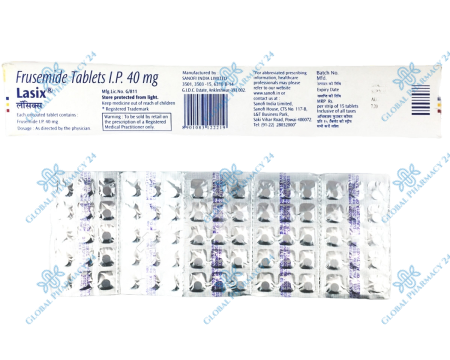| Dosage Forms | Active Ingredient | Duration of Effect | Primary Use |
|---|---|---|---|
| Tablets, Oral solution, Injection | Furosemide | 4-6 hours | Management of edema, hypertension |
Understanding Lasix (Furosemide)
Lasix, scientifically known as Furosemide, stands out in the pharmacological world for its potent diuretic effects. Used primarily to treat edema associated with heart failure, liver disease, and kidney dysfunction, as well as to manage hypertension, Lasix works by inhibiting the absorption of sodium and chloride in the kidney tubules, leading to a significant increase in urine production. This mechanism of action not only helps to relieve the symptoms of fluid overload but also contributes to the lowering of blood pressure.
As a cornerstone in the treatment of various conditions, Lasix's effectiveness and rapid onset make it a critical tool in acute medical scenarios. Its role extends beyond simple fluid removal; it is integral in the management of chronic conditions, offering patients significant relief from symptoms and improving quality of life. The comprehensive understanding of Lasix's pharmacodynamics and pharmacokinetics is essential for healthcare professionals to optimize its therapeutic benefits while minimizing potential risks.
A Deep Dive into Lasix's Composition and Characteristics
At the heart of Lasix's therapeutic prowess is Furosemide, a highly effective loop diuretic that acts on the ascending limb of the loop of Henle in the kidney. This action blocks the reabsorption of sodium and chloride, leading to an increase in urine output. Furosemide's pharmacokinetic properties, including its absorption, distribution, metabolism, and excretion, play a crucial role in its efficacy and safety profile. Understanding these characteristics allows for precise dosing and monitoring, ensuring maximum therapeutic effect and minimal side effects.
The Power of Lasix: Indications and Contraindications
Lasix serves as a versatile agent in treating edema and hypertension, thanks to its powerful diuretic effect. It's indicated for conditions where rapid diuresis is required, such as acute pulmonary edema, congestive heart failure, and chronic kidney disease. The ability of Lasix to rapidly mobilize fluid makes it invaluable in managing these conditions, often leading to prompt symptom relief and stabilization of the patient's status. However, its use is not without constraints; understanding the contraindications and managing risks is pivotal in its application.
Contraindications to Lasix include hypersensitivity to furosemide or sulfonamides, anuria, and hepatic coma or precoma associated with electrolyte imbalances. Special caution is warranted in patients with severe electrolyte depletion, as the drug's action may exacerbate these conditions. Pregnant and lactating women also require careful consideration due to the lack of comprehensive safety data in these populations. This careful balancing of benefits and risks underscores the need for tailored patient management strategies.
The Broad Spectrum of Lasix's Therapeutic Uses
Lasix's ability to induce potent diuresis has made it a mainstay in the treatment of conditions characterized by fluid overload. Its applications extend from acute settings, such as pulmonary edema, to the long-term management of chronic diseases like heart failure and hypertension. By facilitating the rapid removal of excess fluid, Lasix not only alleviates symptoms but also aids in the prevention of complications associated with these conditions, demonstrating its broad therapeutic utility.
When Lasix is a No-Go: Understanding Contraindications
Despite its widespread use, Lasix is not suitable for all patients. Its contraindications, such as severe renal failure with anuria, hepatic coma, and hypersensitivity to furosemide or sulfonylureas, necessitate a careful evaluation of potential risks versus benefits. Additionally, its use in pregnancy and lactation is advised against unless absolutely necessary, highlighting the importance of individualized patient assessment in clinical decision-making.
Lasix in Action: Drug Interactions and Overdose Management
Lasix's interaction with other medications can both potentiate and mitigate its effects, necessitating vigilant management to avoid adverse outcomes. For instance, its concomitant use with aminoglycoside antibiotics may increase the risk of ototoxicity, while simultaneous administration with antihypertensive agents can lead to profound hypotension. Understanding these interactions is crucial for the safe and effective use of Lasix, especially in polypharmacy scenarios common among the elderly and chronically ill.
In cases of overdose, Lasix may lead to profound water and electrolyte depletion, requiring immediate medical intervention. Treatment focuses on symptomatic and supportive care, including correction of electrolyte imbalances and hydration status. In severe cases, hemodialysis may be necessary to remove the drug from the system. Prompt recognition and management of overdose symptoms are key to preventing serious complications.
Handling Lasix: Storage, Packaging, and Dosage
Proper storage and handling of Lasix ensure its therapeutic efficacy and safety. The medication should be stored at room temperature, away from light and moisture, to preserve its stability. Packaging in the form of tablets, oral solution, and injectable forms offers flexibility in administration, catering to the diverse needs of patients. Adherence to recommended storage conditions and packaging instructions is essential to maintain Lasix's effectiveness.
The correct dosage of Lasix varies depending on the condition being treated, patient response, and specific clinical scenario. Starting with the lowest effective dose and adjusting based on therapeutic response and side effects minimizes risks while optimizing benefits. Healthcare providers must tailor the dosing regimen for each patient, considering factors such as renal function, electrolyte balance, and potential drug interactions.
FAQs Lasix
What is Lasix?
Lasix is a brand name for the drug furosemide, which belongs to a class of medications known as diuretics. It is commonly used to treat fluid retention (edema) in conditions such as congestive heart failure, liver disease, or kidney disorders.
How does Lasix work?
Lasix works by increasing the amount of urine produced by the kidneys, thus helping the body get rid of excess salt and water. This helps to reduce swelling and fluid buildup in various parts of the body.
What are the common side effects of Lasix?
Common side effects of Lasix may include dehydration, electrolyte imbalances (such as low levels of potassium, sodium, or magnesium), dizziness, headache, and changes in urination frequency. It's important to consult a healthcare professional if any side effects occur.
How should I take Lasix?
Lasix should be taken exactly as prescribed by your doctor. It is usually taken orally, with or without food. It's important to follow your doctor's instructions carefully and not to exceed the recommended dosage. Be sure to drink plenty of fluids while taking Lasix to prevent dehydration.





















